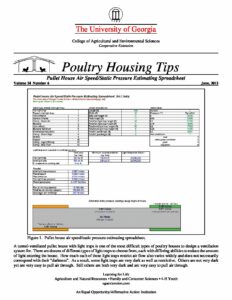A tunnel-ventilated pullet house with light traps is one of the most difficult types of poultry houses to design a ventilation system for. There are dozens of different types of light traps to choose from, each with differing abilities to reduce the amount of light entering the house. How much each of these light traps restrict air flow also varies widely and does not necessarily correspond with their “darkness”. As a result, some light traps are very dark as well as restrictive. Others ...are not very dark yet are very easy to pull air through. Still others are both very dark and are very easy to pull air through.
Complicating matters is that the amount of light trap required depends not only on the air moving capacity of the fans, but also how well the fans perform under pressure. As you might expect, the more fans installed the more light trap required. But, what many people do not realize is that the better a fan holds up under pressure (pressure created when pulling air through fan and inlet light traps) the less light trap is required. So, selecting the right fan can reduce the amount of light trap required and thus reduce costs, too.
Though there are general guidelines for the amount of light trap a house requires based on the total air moving capacity of the tunnel fans, these guidelines often leave many questions unanswered. For instance, how much more air speed will I get if I install two more light traps on my tunnel inlet? Would I get more air speed if I added another tunnel fan and did not install any additional light traps? What would happen to my air speed if I added discharge cones to my fans without adding any light traps?
In the past, the answer to these questions would have been very difficult to determine. But, recently a new Excel spreadsheet has been developed that allows the user to accurately predict the air speed in a pullet house based on the type and number of fans and light traps installed. All users have to do is to input basic house dimensions, type of light trap they would like to install on the tunnel inlet as well as on the tunnel fans, the amount of air the fan they plan to install moves at static pressure ranging from 0.00" to 0.30", the number and condition of the tunnel fans. The spreadsheet then gives a suggested minimum amount of fan and inlet light trap required. The user can then use this prescribed minimum light trap areas or they can choose to enter a higher or lower amount if desired. The user can also choose to add evaporative cooling pads to their tunnel inlet opening. After the data has been entered the spreadsheet then calculates the resulting average air speed as well as the static pressure along the length of the house. The user can then do things such as change the number of fans and then add an evaporative cooling pad system and see what would happen to house air speed and static pressure. For instance, adding a fan to the house in Figure 1 without adding light trap would only increase the average air speed 28 ft/min due to the fact that the total static pressure would increase from 0.157" to 0.18". If an evaporative cooling pad system was then installed in front of the inlet light traps the air speed would decrease 38 ft/min because of the additional resistance/pressure caused by drawing air through the evaporative cooling pads would significantly reduce the air moving capacity of the fans.
Details
| Year | Volume | Number | Categories |
|---|---|---|---|
| 2012 | 24 | 6 |

